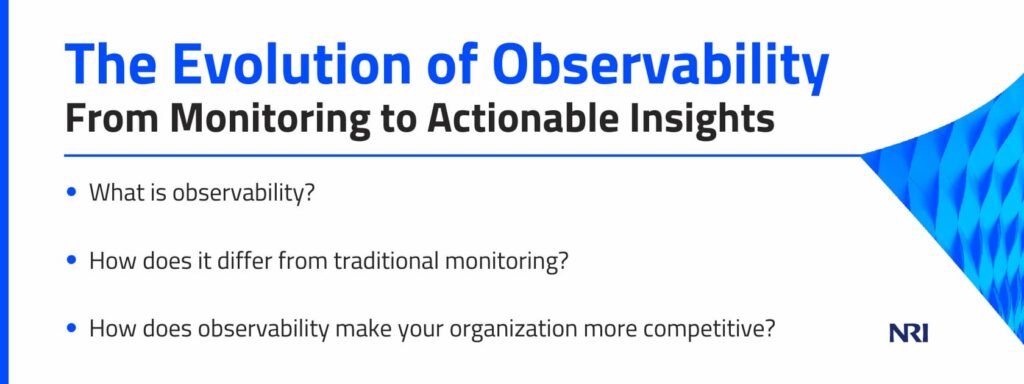Discover “why”, not just “what” is happening in your technology ecosystem.

Organizations now face unprecedented complexity in their IT environments. The shift from monolithic architectures to distributed, cloud-native systems has exposed critical limitations in traditional monitoring. As organizations strive to maintain reliability and performance in increasingly complex IT ecosystems, observability has emerged as a vital capability, transforming how teams detect, diagnose, and resolve issues across their digital infrastructure.
Here’s all you need to know:
The Early Days: Traditional Monitoring
Traditional monitoring systems were designed for a simpler era in IT infrastructure. They relied on predefined rules to connect incidents. Generally, they focused on basic uptime metrics, resource utilization (like CPU, memory, and disk space), and simple alert mechanisms triggered by threshold violations. These systems were reactive by nature—for example, they could tell you when a server went down, but not why it happened or the broader impact.
This approach adequately served organizations when systems were predominantly monolithic and changes were infrequent. However, its limitations have become increasingly apparent as IT environments grow more complex. For example, these systems tend to create data silos. Organizations often end up with separate monitoring solutions for networks, servers, applications, and databases, each providing only a partial view of the infrastructure.
Additionally, Traditional monitoring systems don’t provide comprehensive insights into the dependencies of different components. This makes troubleshooting complex issues time-consuming and labor-intensive, as engineers must manually correlate data from various sources to determine the root cause.
As applications and infrastructure become more distributed, dynamic, and complex, organizations need a more sophisticated approach to effectively understanding and managing their systems.
The Rise of Observability
Observability provides a more holistic way to understand system behavior. It is built on three pillars:
- Detailed logs of events that allow teams to analyze sequences of activities and debug issues. Logs provide rich context about what happened at specific points in time.
- Quantifiable metrics to help teams track real-time system behavior over time, providing insights into performance, resource utilization, and business processes.
- Traces of request flows across distributed services that provide insights into bottlenecks, dependencies, and latency. Traces show how requests propagate through a system, making it easier to identify where issues occur.
Unlike monitoring, which focuses on known issues and predefined metrics, observability is about gaining insights into unknown issues and understanding the “why” behind system behavior.
This philosophical shift moves IT teams from asking “Is the system up?” to “How well is the system serving our users?” It’s about understanding not just what is happening but also why it’s happening and its impact on business outcomes.
Key Drivers Behind the Evolution
The Shift to Microservices, Containers, and Hybrid Cloud
- Microservices: With hundreds of independent services communicating with each other, understanding the flow of requests and the impact of service failures is crucial.
- Containers: The ephemeral nature of containers means that traditional monitoring tools may miss short-lived issues or fail to capture the relationship between containers and their services.
- Hybrid Cloud: Managing resources across multiple cloud environments creates visibility challenges that traditional monitoring tools struggle to address.
Growing Demands for Uptime, User Experience, and SLA Adherence
As digital services have become central to business operations, the tolerance for downtime and performance issues has decreased dramatically. Organizations now face:
- Stricter SLAs: Service Level Agreements have become more demanding, with many businesses requiring 99.99% uptime or better.
- User Experience Focus: Technical metrics like CPU utilization are no longer sufficient; organizations need to understand how system performance affects actual user experience.
- Real-Time Business Impact: Issues need to be understood in technical terms, as well as how they impact business outcomes and customer satisfaction.
Increasing Complexity and Interdependence of IT Systems
This manifests in several ways:
- Dependency Chains: A single user request might touch dozens of services, databases, and third-party APIs.
- Configuration Complexity: Modern systems have countless configuration parameters that can interact unpredictably.
- Multiple Layers: Issues can occur at any layer of the stack, including hardware, virtualization, containerization, application code, or external dependencies.
From Visibility to Actionability
Having visibility into system behavior is only valuable if it leads to action. Observability transforms raw data into actionable insights so that you can drive better decisions and faster resolution of issues.
Enabling Root Cause Analysis and Predictive Insight
By correlating data across logs, metrics, and traces, observability platforms can identify patterns and relationships that point to the root cause of issues. This capability transforms troubleshooting from a time-consuming, manual process to a more efficient, data-driven approach.
Integration with AIOps, Automation, and Incident Response Workflows
The power of observability is amplified when it’s integrated with AIOps (Artificial Intelligence for IT Operations) and automation tools.
This integration allows for:
- Automated remediation: Common issues can be automatically resolved without human intervention, reducing downtime and freeing up IT staff for more strategic work.
- Intelligent alerting: Instead of flooding teams with alerts, AIOps-enhanced observability can identify the most critical issues that require immediate attention.
- Continuous improvement: By analyzing the effectiveness of remediation actions, these systems can learn and improve over time, becoming more efficient at addressing recurring issues.
Moving from Dashboards to Intelligent, Context-Rich Alerts and Decisions
Modern observability goes beyond passive dashboards to provide active, intelligent notifications with the context needed for quick decision-making.
- Instead of simply notifying that a threshold has been breached, alerts include information about related services, recent changes, and potential business impact.
- Observability platforms can suggest the most effective remediation strategies based on historical data and learned patterns.
- Technical issues are translated into business terms, helping IT teams prioritize based on actual business impact rather than technical severity.
It’s not just about seeing more—it’s about understanding better and acting faster.
Business Impact and Strategic Value of Observability
Observability delivers substantial business value, including.
- Faster resolution and less downtime, leading to a better end-user experience
- Allowing proactive performance management and capacity planning
- Supporting your digital transformation and agility
Therefore, forward-thinking organizations must proceed with adoption to increase their competitiveness.
What’s Next and How to Prepare
As observability continues to evolve, organizations should as well. Observability should not be viewed as a standalone initiative but as a core component of a comprehensive IT operations strategy. This will eliminate information silos and address IT monitoring effectively by bringing all monitoring data under a single pane of glass.
Future trends include:
- Observability + AIOps: This trend will accelerate, with AI taking on more responsibility for analyzing observability data, identifying patterns, and recommending or implementing solutions.
- Digital twins: Virtual representations of physical systems will become more common, allowing organizations to simulate changes and understand their potential impact before implementing them in production.
- Edge observability: As computing continues to move to the edge, observability solutions must adapt to monitor and analyze distributed systems with limited connectivity and resources.
Where are you with your digital transformation? NRI can help you assess your observability maturity and evolve your capabilities to stay ahead of the digital curve. Get your free assessment today.



